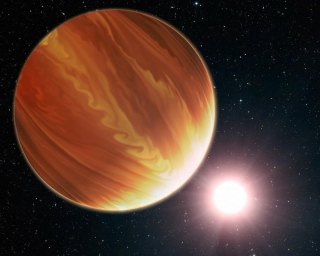
This is an illustration of the gas giant planet HD 209458b in the constellation Pegasus. Astronomers found much less water vapor in the hot world’s atmosphere than predicted. Image: NASA.
The scientists, using NASA's Hubble Space Telescope, examined three planets orbiting stars similar to the sun. The planets, known as HD 189733b, HD 209458b and WASP-12b, are between 60 and 900 light-years away from Earth. They were thought to be ideal candidates for atmospheric water vapor because they have high temperatures that cause water to turn into measurable vapor.
These so-called “hot Jupiters” are so close to their stars they have temperatures between 1,500 and 4,000 degrees Fahrenheit; however, the planets were found to have only one-tenth to one-one-thousandth the amount of water predicted by standard planet-formation theories.
"Our water measurement in one of the planets, HD 209458b, is the highest-precision measurement of any chemical compound in a planet outside our solar system, and we can now say with much greater certainty than ever before that we've found water in an exoplanet," said Nikku Madhusudhan of the Institute of Astronomy at the University of Cambridge, England. "However, the low water abundance we have found so far is quite astonishing."
Madhusudhan, who led the research, said that this finding presents a major challenge to exoplanet theory. "It basically opens a whole can of worms in planet formation. We expected all these planets to have lots of water in them. We have to revisit planet formation and migration models of giant planets, especially 'hot Jupiters,' and investigate how they're formed."
He emphasized that these results may have major implications in the search for water in potentially habitable Earth-sized exoplanets. Instruments on future space telescopes may need to be designed with a higher sensitivity if target planets are drier than predicted.
The findings were published July 24 in The Astrophysical Journal Letters.
Related: